VVAM Newsletter 88 – 2002
Friends of the Airborne Museum
Editors:
Drs. R.P.G.A. Voskuil
C. van Roekel
G.H. Maassen jr.
Newsletter No. 88, October 2002
Translated by Cathrien and Peter Clark
Representative in Great Britain: Niall Cherry, 3 Church Road, Warton, Lancs, PR4 1BD Tel. home 0177-2632764
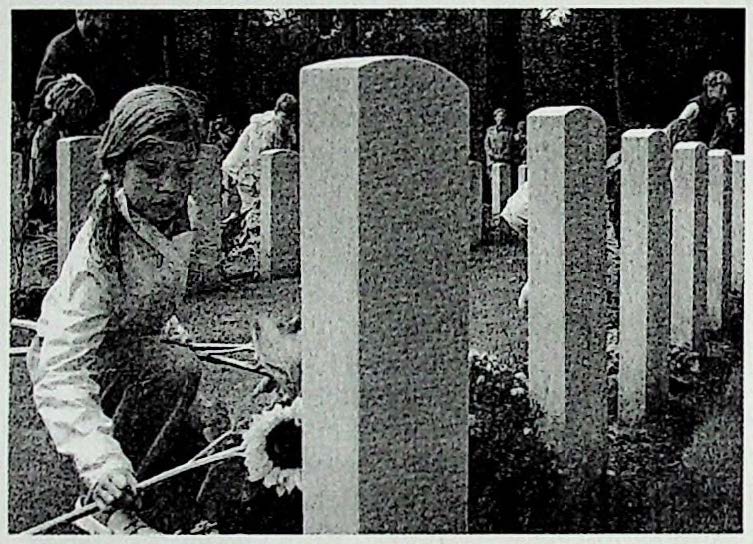 Airborne Cemetery Oosterbeek, 22 September 2002.
Airborne Cemetery Oosterbeek, 22 September 2002.
Children place flowers on the graves during the memorial service.
(photo: Berry de Reus)
From the editors
Much of note has happened over the past weeks including the 58th commemoration of the Battle of Arnhem, so many in fact that we are only able to cover a few in this issue due to lack of space. The remaining reports will be published in the next Newsletter.
Theme afternoon, 2 November 2002
Our society is organising a theme afternoon to be held in Zalencentrum ‘Lebret’ in Lebretweg, Oosterbeek on 2 November next.
The programme is as follows: 13.30 – 1.4.00 hours: Reception of the members.
14.00 – 15.00 hours: Lecture by Marcel Zwarts on the deployment of German armour during the Battle of Arnhem. Marcel has researched this subject for many years and recently published the book ‘German Armored Units at Arnhem, September 1944′. The lecture will be lavishly illustrated with slides.
15.00 -15.45 hours:
BREAK.
15.45 – 16.30 hours: Second part of Marcel Zwarts’ lecture.
16.30 – 17.00 hours: Time for questions, discussions and chats.
Ca. 17.15 hours: End of the theme afternoon.
Appeal
Patrick Pronk, author of the book ‘Airborne Engineers, The Shiny 9lh’, is busy compiling details on the history of the 1st Parachute Squadron, Royal Engineers. He is looking for documents, personal accounts, photographs etc. People who are interested in helping him, especially veterans from this unit, are kindly asked to contact Patrick Pronk, Doomstraat 279, 2584 AM Scheveningen, Holland, telephone 070 3545581, e-mail: PJPronk@hotmail.com.
Obituary: Henry McAnelly, battlefield guide
Arnhem veteran Henry McAnelly passed away at his home in Kortenhoef on 11 July this year. He was 79 years of age. For almost thirty years Henry conducted people around the area of the Battle of Arnhem.
In September 1944 he was a private in a 1st Parachute Brigade mortar platoon. During the advance to Arnhem he was seriously wounded at Mariendaal, an area between Oosterbeek and Arnhem. He lost his left arm and received multiple bullet and shrapnel wounds to his head and body. He was taken to St. Elisabeths Gasthuis and from there to the Koning Willem III barracks in Apeldoorn, where he underwent an operation on his wounds. At the end of October he was transferred to Stalag 7 prisoner of war camp at Freising. There he was given further treatment, this time by German doctors. Shortly before Germany capitulated he was taken to Marseilles via Switzerland and France, where he was put on board a hospital ship bound for Liverpool.
He was hospitalised for long periods after the war. When he had recovered he travelled every year to Oosterbeek in order to visit the former battlefield. In 1954 he moved to the Netherlands where he had found employment. Following his early retirement he began giving guided tours of the Arnhem battle area. He continued to do this for almost thirty years. His experiences were used by the author Edward Monroe-Jones in his book ‘Before I Sleep, A novel about Arnhem’, that was published in 1990.
Commemorative envelope 2002
On 17 September 2002 the Airborne Museum in Oosterbeek issued its annual commemorative envelope. This issue is the seventh in the series: ‘Monuments of the Battle of Arnhem’.
The envelope shows the monument to the 101st US Airborne Division on the Drielse Rijndijk near Heteren.
The 101st US Airborne Division took over the positions between Opheusden and Elst from the 43rd British (Wessex) Division on 4 October 1944. At Opheusden the Americans were involved in bitter fighting with the German 363rd Volksgrenadier Division. The Germans had crossed the Rhine and begun advancing from Kesteren towards Opheusden-Dodewaard, supported by tanks. This ‘Battle of Opheusden’ continued until 15 October. Easy Company, 506th Parachute Infantry Regiment – the ‘Band of Brothers’ – was also engaged in this battle.
During the night of 22/23 October, 138 British, 10 Dutch and two Russians left Renkum to cross the Rhine with the aid of the Dutch resistance and Easy Company, and successfully reached the American lines. This action was codenamed ‘Operation Pegasus’.
Six days later six American parachutists carried out a reconnaissance patrol to Ede, and returned the following day with 32 German prisoners, a feat of arms that became known as the ‘Incredible Patrol’.
The Americans were relieved on 29 November. The defence of the Betuwe, also called ‘The Island’, cost the 101st Airborne Division more than 300 dead. The monument on the Rijndijk near Heteren commemorates their deployment. It was erected by members of the ‘101st Airborne Committee Betuwe’ and was unveiled on 15 September 1982.
An issue of 300 numbered copies of the commemorative envelopes have been produced and franked ’17 September 2002′ with the philatelists’ stamp of the Oosterbeek post office.
The first example was presented to the ‘Leader of the Pilgrimage’ 2002 Sir James Cleminson. In September 1944 he commanded 5th Platoon, B Company, 3rd Parachute Batallion.
The commemorative envelopes are for sale in the Airborne Museum Oosterbeek at € 3,00.
Limited numbers from previous years are available at the museum. Refer also to our website: www.airbornemuseum.com.
16 September 2002. Former Friends’ Society chairman Chris van Roekel receives a copy of the book ‘Operation Market-Garden, Then and Now’from author Karel Margry. Chris was given the book in appreciation of all the work he has done for our society over the last twenty years. This gift was promised him during his farewell on 6 April this year, when he received a ‘symbolic book token’ prior to it’s publication.
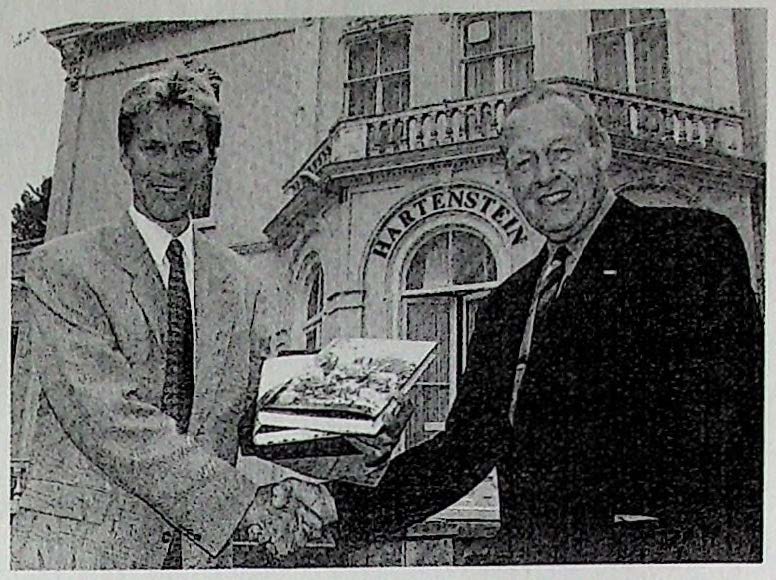 (photo: Berry de Reus)
(photo: Berry de Reus)
‘Operation Market-Garden, Then and Now’
Monday afternoon 16 September 2002 saw the ‘unveiling’ in the ‘Hartenstein’ of the monumental literary work ‘Operation Market-Garden, Then and Now’. After H.R.H. Prince Bernhard had received a copy of the book from the author elsewhere earlier that day, the official first copy was presented to the trustees of the Airborne Museum Foundation for the museum library. This ceremony brought to an end, after more than twelve years, a comprehensive work from author Karel Margry.
For many years Karel, not unknown to the Friends, has edited the magazine ‘After the Battle’, which appears in the Netherlands under the title ‘Toen en Nu’. Therefore, the recently published book naturally follows the style with which we are familiar from the periodical. This, combined with Karel’s almost encyclopaedic knowledge of operation Market Garden, has resulted in an outstanding publication. Neither did the author hesitate to ask many experts their advice on specific battle sectors.
The entire operation, the British, Polish and American airborne landings as well as the advance of the ground forces – including the army corps that provided flank protection – is pictured day by day, sometimes hour by hour, in two volumes containing 2340 photographs. The captions are very detailed and informative. The concept of wartime photographs and photos of the present day situation makes for a ‘Market Garden battlefield tour’ that can be followed from an armchair at home, or in the field with the books as guides.
If we limit ourselves to the ‘Arnhem’ section alone we come across still more previously unknown photographs. These were unearthed thanks to Karel’s intensive detective work in archives, museums, press offices and private collections. Karel has arranged (all) the well known photographs by the British war photographers in the sequence in which they were taken. This sometimes produces surprises. Various photos appear to have been taken at locations other than was generally assumed. The many known photographs from the German Bundesarchiv (National Archive) are presented in the same way. Among other things, Karel also shows which operational plans were found by the Germans in a crashed Allied glider as well as the aircraft in which they were found. Although the reconnaissance photos showing the presence of German tanks in the Arnhem area were not traced, the author provides many new facts on the subject.
These are two volumes to be read at one sitting, although at the expense of some sleep, and then for regular leafing through. The book is only available in English, and the two parts come in a rigid box. Despite the high price it is a must for anyone interested in operation Market Garden. It is for sale in the museum shop.
Karel Margry, ‘Operation Market-Garden, Then and Now’. ISBN 1 870067 39 8. Published by Battle of Britain International Ltd, Church House, Church Street, London, E15 3JA, United Kingdom. The book contains 720 pages and is illustrated with photos, maps and tables. The price: € 130. (Wybo Boersma)
Niall Cherry lecture
On Sunday afternoon of 8 September 2002, around thirty members gathered in the side room of the Schoonoord restaurant in Oosterbeek to listen to three short lectures by our UK representative Niall Cherry. The first subject was the battle for the Van Limburg Stirumschool at the Rhine bridge in Arnhem. According to the speaker the days’ long defence of this building by a small group of men against overwhelming German odds was an act of great courage and bravery. His next story also involved events at the bridge and concerned Leo Hall, ‘Bombardier’ with the 1st Airlanding Light Regiment, Royal Artillery. In his third lecture Niall dealt with the experiences of Doctor Lipmann Kessel and his escape from Apeldoorn.
These three clearly and unambiguously told stories were followed by questions from the floor, most of which Niall was able to answer! One question that had to remain unanswered: ‘Why was the commander of the 1st Airlanding Light Regiment, Royal Artillery, Lieutenant Colonel W.F.K. Thompson, known as ‘Sheriff’ Thompson?’ Reactions please to the editors!
When the presentations were over most of those who attended remained behind chatting for quite a while.
Niall promised he would be back in September 2004 to discuss a number of other subjects. We look forward to it!
8 September last. Niall Cherry gives a lecture in the Schoonoord restaurant in Oosterbeek.
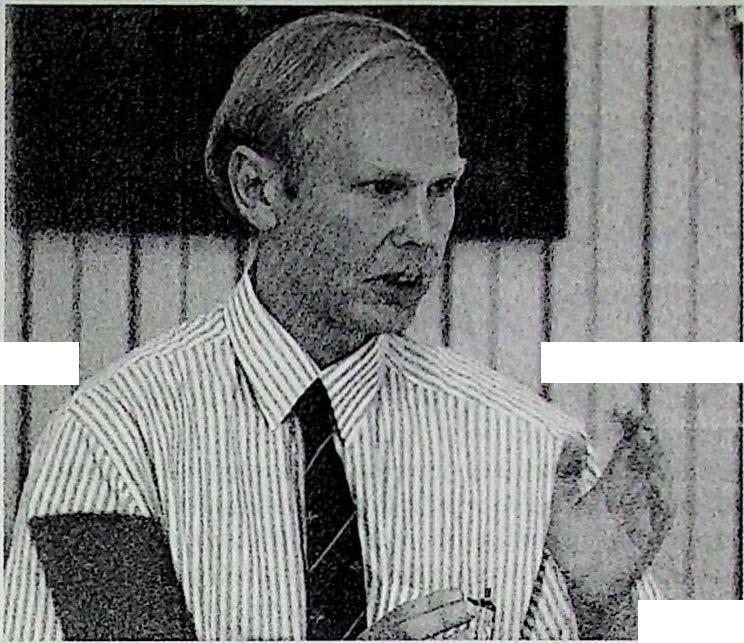 (photo: Berry de Reus)
(photo: Berry de Reus)
‘Luchtalarm op de Veluwe’ (Air raid alert in the Veluwe)
The book ‘Luchtalarm op de Veluwe’ (by Wolter Noordman) relates the experiences of the crew of the American bomber 42-52506 (a Liberator) that crashed near Hierden in the Northern Veluwe on 29 April 1944. Some of the crew make contact with the resistance and manage to go into hiding. It is principally their experiences that Noordman describes in minute detail. For this he makes use of various publications, numerous archives and eyewitness accounts.
In November 1944 a few airmen take part in operation Pegasus II, in which an attempt is made to help more than one hundred British Airborne and other allied servicemen to escape across the Rhine to the liberated South Netherlands. That the attempt failed is well known.
Noordman provides a comprehensive account of Pegasus II which includes a list of participants.
The author paints a vivid picture of the resistance in the Northern Veluwe. He highlights the difficulties faced by the helpers and the allied servicemen in keeping out of German clutches. No one will be surprised to learn that luck played a big part in this.
Generally speaking the story is a little fragmented. The author had the choice of a description per person, making repetition inevitable, or following a chronological sequence which could affect the flow. The book is liberally provided with notes, a list of sources and a good acknowledgement of photographs, something which other books often lack. A simple map might have been useful for people not familiar with the Veluwe.
The book is highly recommended. Those interested in the air war as well as the Resistance, and/or operation Market Garden will find their individual tastes well catered for in this publication.
‘Luchtalarm op de Veluwe’, by Wolter Noorman, was published in 2002 by Kok in Kampen (ISBN 90 435 0523 4), contains 172 pages, and is illustrated with photographs. It can be ordered through the regular bookshops and is for sale in the Airborne Museum. Price € 14.95.
(W. Boersma)
New photograph discovered
One of our members, who for reasons best known to himself wishes to remain anonymous, recently came up with an unusual photograph. It is a snapshot taken in the Arnhem region in September 1944. The print shows a German tracked vehicle of a type that was known to have operated at Arnhem but of which there had been no photographic evidence of that fact till now.
The photo was taken by Ruud van der Sijde, who at the time lived at the corner of Utrechtseweg/ Rosandelaan in the western outskirts of Arnhem. Ruud snapped a Jagdpanzer IV on Monday 18 September 1944 as it drove past his house along Utrechtseweg on the way to Oosterbeek.
Our experts are busily arranging all the data regarding (the deployment of) this tank hunter, the unit to which it belonged, and its direct British opponents. We hope to return to this interesting topic in more detail in a future Newsletter.
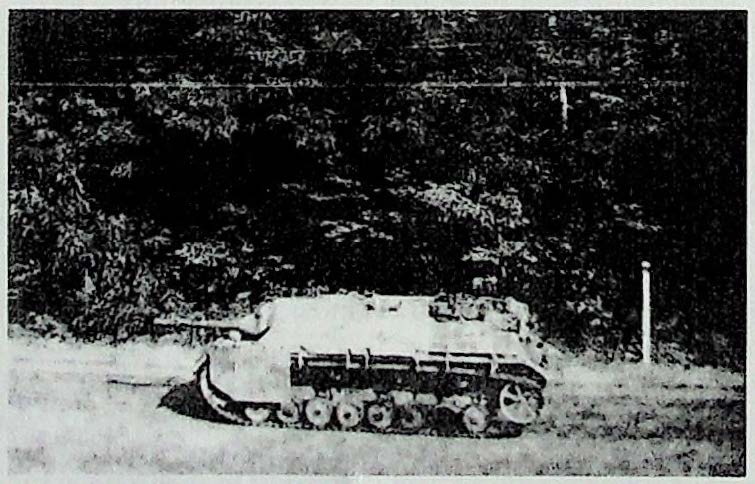 A Jagdpanzer IV on Utrechtsezveg in Arnhem, at the junction with Rosandelaan, driving in the direction of Oosterbeek, 18 September 1944.
A Jagdpanzer IV on Utrechtsezveg in Arnhem, at the junction with Rosandelaan, driving in the direction of Oosterbeek, 18 September 1944.
(photo R. van der Sijde)
Addition to the Roll of Honour
According to Jan Hey’s standard work it concerns Dakota No. KG-418 from 512 Squadron, that was piloted by Flight Lieutenant R.S.F. Matthews. Fortunately there were no fatalities when it crashed on 20 September 1944, which, however, makes it difficult if not impossible to determine the exact spot.
An aerial photo on page 733, Volume 2, of the well known book series ‘Blik Omhoog’ by author Cor Janse, shows the Buunderkamp area near Ginkel Heath where a crash-landed Dakota can be seen. The caption identifies the machine as a Stirling, but this fault is corrected on page 1345 of the supplement. Could this have been Matthews’ aircraft?
Contact was made with Canadian Floyd Willston via the Internet and he was prepared to look into what befell the crew of KG-418, now 58 years ago. It transpired that they were captured by the Germans shortly after crash-landing but survived the war. One of them died soon after, on 17 October 1945 to be precise. This was Warrant Officer Peter B. Tonner (from Canada), who, on his return from Germany, had been promoted to Flying Officer.
Floyd traced the Tonner family, and they were able to tell that Peter died at the age of 26 as the result of acute tuberculosis and meningitis contracted during his time as a prisoner of war. The conclusion reached was that Peter Tonner warranted being seen as a victim of the Battle of Arnhem, something with which Jan Hey heartily agrees. Peter’s details (and those of the other crew members and the aircraft) will be included in the next edition of the Roll of Honour.
The Dakota took part in a re-supply mission on Wednesday 20 September 1944 crewed by: Flight Lieutenant R.S.F. Matthews (pilot), Flight Sergeant W.C. Thompson (2nd pilot), Warrant Officer D.W. Bromige (navigator) and Warrant Officer P.B. Tonner (radio-operator). There were also four Air Despatches on board (responsible for ejecting the supplies), but alas their names are not known.
The question remains: is the Dakota in the photo in ‘Blik Omhoog’ that of Matthews and Tonner? In a Canadian report compiled just after Peter’s return, he states that his machine came down about ten miles from Ede. A search of the site where the aircraft in Cor Janse s book ended its career unearthed some ‘finds’, but nothing to prove they were from KG-148. Who has the answer?
(Geert Maassen)
Naturally, a certain amount of research had to be done for the ‘Wings – by air to Arnhem’ exhibition held recently in Oosterbeek town hall. This research was carried out by Philip Reinders and included the history of the aircraft that crashed in September 1944 in missions associated with Market Garden.
The Roll of Honour (an honour list of the fallen) mentions an aircraft whose crash site is unknown.
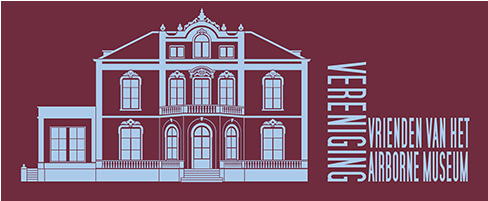
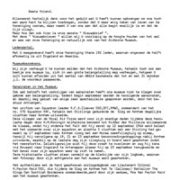
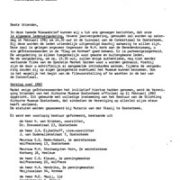
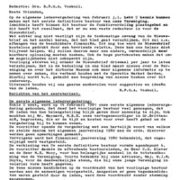
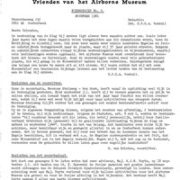
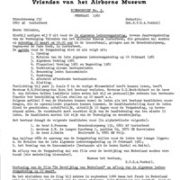
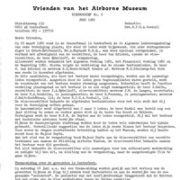
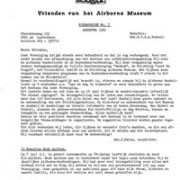
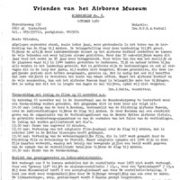
Plaats een Reactie
Vraag of reactie?Laat hier uw reactie achter.